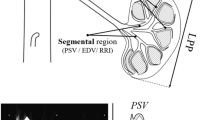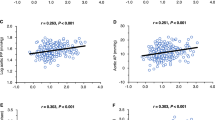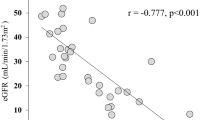Abstract
Microalbuminuria is a risk factor for cardiovascular events and death in hypertensive patients. Patients who are expected to increase albuminuria need strict blood pressure control. In the present study, we assessed the association between the renal resistive index (RI) and future increases in albuminuria in patients with essential hypertension. Sixty-six patients with essential hypertension were included in the study. Univariate and multivariate logistic regression analyses were used to identify the factors, including renal RI, that were significant independent determinants of increased in urinary albumin excretion (UAE), defined as an increase of >50% in the urinary albumin-to-creatinine ratio over 2 years. Receiver operator characteristics curve analysis was used to select the optimal cut-off point that predicted an increase in UAE. RI was the only significant variable that predicted the increase in UAE, with the optimal cut-off value of renal RI that predicted this increase being 0.71 (sensitivity 52.4% and specificity 84.4%). Renal RI is associated with the future increase in albuminuria in patients with essential hypertension.
This is a preview of subscription content, access via your institution
Access options
Subscribe to this journal
Receive 12 digital issues and online access to articles
$119.00 per year
only $9.92 per issue
Buy this article
- Purchase on Springer Link
- Instant access to full article PDF
Prices may be subject to local taxes which are calculated during checkout

Similar content being viewed by others
References
Pontremoli R, Nicolella C, Viazzi F, Ravera M, Sofia A, Berruti V et al. Microalbuminuria is an early marker of target organ damage in essential hypertension. Am J Hypertens 1998; 11: 430–438.
Doi Y, Iwashima Y, Yoshihara F, Kamide K, Takata H, Fujii T et al. Association of renal resistive index with target organ damage in essential hypertension. Am J Hypertens 2012; 25: 1292–1298.
Yudkin JS, Forrest RD, Jackson CA . Microalbuminuria as predictor of vascular disease in non-diabetic subjects. Islington Diabetes Survey. Lancet 1988; 2: 530–533.
Borch-Johnsen K, Feldt-Rasmussen B, Strandgaard S, Schroll M, Jensen JS . Urinary albumin excretion. An independent predictor of ischemic heart disease. Arterioscler Thromb Vasc Biol 1999; 19: 1992–1997.
Gerstein HC, Mann JF, Yi Q, Zinman B, Dinneen SF, Hoogwerf B et al. Albuminuria and risk of cardiovascular events, death, and heart failure in diabetic and nondiabetic individuals. JAMA 2000; 286: 421–426.
Hillege HL, Fidler V, Diercks GF, van Gilst WH, de Zeeuw D, van Veldhuisen DJ et al. Urinary albumin excretion predicts cardiovascular and noncardiovascular mortality in general population. Circulation 2002; 106: 1777–1782.
Gosling RG, Dunbar G, King DH, Newman DL, Side CD, Woodcock JP et al. The quantitative analysis of occlusive peripheral arterial disease by a non-intrusive ultrasonic technique. Angiology 1971; 22: 52–55.
Norris CS, Barnes RW . Renal artery flow velocity analysis: a sensitive measure of experimental and clinical renovascular resistance. J Surg Res 1984; 36: 230–236.
Petersen LJ, Petersen JR, Ladefoged SD, Mehlsen J, Jensen HA . The pulsatility index and the resistive index in renal arteries in patients with hypertension and chronic renal failure. Nephrol Dial Transplant 1995; 10: 2060–2064.
Shimizu Y, Itoh T, Hougaku H, Nagai Y, Hashimoto H, Sakaguchi M et al. Clinical usefulness of duplex ultrasonography for the assessment of renal arteriosclerosis in essential hypertensive patients. Hypertens Res 2001; 24: 13–17.
Tedesco MA, Natale F, Mocerino R, Tassinario G, Calabrò R . Renal resistive index and cardiovascular organ damage in a large population of hypertensive patients. J Hum Hypertens 2007; 21: 291–296.
Pontremoli R, Viazzi F, Martinoli C, Ravera M, Nicolella C, Berruti V et al. Increased renal resistive index in patients with essential hypertension: a marker of target organ damage. Nephrol Dial Transplant 1999; 14: 360–365.
Hashimoto J, Ito S . Central pulse pressure and aortic stiffness determine renal hemodynamics: pathophysiological implication for microalbuminuria in hypertension. Hypertension 2011; 58: 839–846.
Kuznetsova T, Cauwenberghs N, Knez J, Thijs L, Liu YP, Gu YM et al. Doppler indexes of left ventricular systolic and diastolic flow and central pulse pressure in relation to renal resistive index. Am J Hypertens 2015; 28: 535–545.
Doi Y, Iwashima Y, Yoshihara F, Kamide K, Hayashi S, Kubota Y et al. Renal resistive index and cardiovascular and renal outcomes in essential hypertension. Hypertension 2012; 60: 770–777.
Toledo C, Thomas G, Schold JD, Arrigain S, Gornik HL, Nally JV et al. Renal resistive index and mortality in chronic kidney disease. Hypertension 2015; 66: 382–388.
Mostbeck GH, Kain R, Mallek R, Derfler K, Walter R, Havelec L et al. Duplex Doppler sonography in renal parenchymal disease. Histopathologic correlation. J Ultrasound Med 1991; 10: 189–194.
Ikee R, Kobayashi S, Hemmi N, Imakiire T, Kikuchi Y, Moriya H et al. Correlation between the resistive index by Doppler ultrasound and kidney function and histology. Am J Kid Dis 2005; 46: 603–609.
Okura T, Kurata M, Irita J, Enomoto D, Jotoku M, Nagao T et al. Renal resistance index is a marker of future renal dysfunction in patients with essential hypertension. J Nephrol 2010; 23: 175–180.
Jalal DI, Rivard CJ, Johnson RJ, Maahs DM, McFann K, Rewers M et al. Serum uric acid levels predict the development of albuminuria over 6 years in patients with type 1 diabetes: findings from the coronary artery calcification in type 1 diabetes study. Nephrol Dial Transplant 2010; 25: 1865–1869.
Hellemons ME, Lambers Heerspink HJ, Gansevoort RT, de Zeeuw D, Bakker SJ . High-sensitivity troponin T predicts worsening of albuminuria in hypertension; results of a nested case-control study with confirmation in diabetes. J Hypertens 2013; 31: 805–812.
Matsuo S, Imai E, Horio M, Yasuda Y, Tomita K, Nitta K et al. Revised equations for estimated GFR from serum creatinine in Japan. Am J Kidney Dis 2009; 53: 982–992.
Okura T, Watanabe S, Miyoshi K, Fukuoka T, Higaki J . Intrarenal and carotid hemodynamics in patients with essential hypertension. Am J Hypertens 2004; 17: 240–244.
Schmieder RE, Mann JF, Schumacher H, Gao P, Mancia G, Weber MA et al. Changes in albuminuria predict mortality and morbidity in patients with vascular disease. J Am Soc Nephrol 2011; 22: 1353–1364.
Leoncini G, Martinoli C, Viazzi F, Ravera M, Parodi D, Ratto E et al. Changes in renal resistive index and urinary albumin excretion in hypertensive patients under long-term treatment with lisinopril or nifedipine GITS. Nephron 2002; 90: 169–173.
Watanabe S, Okura T, Kurata M, Irita J, Manabe S, Miyoshi K et al. Valsartan reduces serum cystatin C and the renal vascular resistance in patients with essential hypertension. Clin Exp Hypertens 2006; 28: 451–461.
Miyoshi K, Okura T, Nagao T, Jotoku M, Enomoto D, Irita J et al. HbA1c is an independent determinant of renal vascular resistance estimated by Doppler sonography in non-diabetic hypertensive patients. Clin Med Insights Endocrinol Diabetes 2008; 1: 21–26.
Author information
Authors and Affiliations
Corresponding author
Ethics declarations
Competing interests
Dr JH received research grants and speaker honoraria from Actelion Pharm. Jpn., Astellas Pharm. Inc., Beringer-Ingerheim Japan Co., Daiichi-Sankyo Inc., Sumitomo Dainippon Pharm., Kyowa Hakkoh Kirin Co., MSD Co., Mitsubishi Tanabe Co., Mochida Pharm Co. Ltd., Otsuka Pharm Co Ltd., Sanofi Aventis Co., Pfizer Health Care Inc., Shionogi Pharm Co. Ltd., Takeda Pharm. Co., Ltd. The remaining authors declare no conflicts of interest.
Rights and permissions
About this article
Cite this article
Miyoshi, K., Okura, T., Tanino, A. et al. Usefulness of the renal resistive index to predict an increase in urinary albumin excretion in patients with essential hypertension. J Hum Hypertens 31, 66–69 (2017). https://doi.org/10.1038/jhh.2016.38
Received:
Revised:
Accepted:
Published:
Issue Date:
DOI: https://doi.org/10.1038/jhh.2016.38
This article is cited by
-
Diurnal variation of renal resistive index over 24-hour period in hypertensive patients and healthy controls
Abdominal Radiology (2019)



